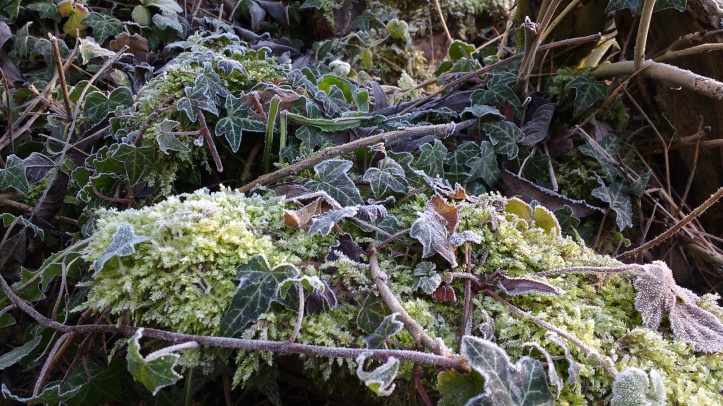
An Arboretum is often considered to be at its most resplendent in the autumn when the fading sun triggers deciduous trees to starve their foliage of fluids and in turn the remaining chlorophyll degrades into an artists pallet of pigments; shades of yellow ochre, magenta, rusty-reds and deep plum-purples burst to the fore in vast swathes. The landscape of the entire British countryside is transformed into a living work of art. Now, in January and with all trace of autumn colour now gone, winters frosted fingers transforms the new year landscape again. The Arboretum, cloaked in hoar frost, remains just as beautiful.
Pressed flat against the bleached sky, heaven white with morning sun fractured and dispersed by the mist rising from the slowly warming ground, the bare bones of the trees appear black, one-dimensional, like a scene from a Tim Burton animation. The grass crunches pleasingly underfoot and on every branch, every leaf, ice crystals cling like sugar-coating. The bareness of the trees brings to life their feathered inhabitants, hiding places in short supply. Silhouettes flit from branch to branch; if the flora appears lifeless then the fauna is, in stark contrast, overwhelmingly alive. Bird song rings out and resonates from the solid wood of bare Oaks and Birch, unhindered by foliage that would otherwise soak up the sounds of high pitch trills and low rumbles of raucous Crow-call. Everywhere shapes shift in the hollow hedgerows as birds search frantically for the next meal, Thrushes and Blackbirds toss leaf litter from the woodland floor in search of worms and insects. This is life in the open, easily observed. One of winters gifts to us.

I’ve long been a fan of the Shady Lane Arboretum. In fact, it was here that on a cold November morning, in the first snow of winter, I got down on one knee in a circle of pines and proposed to my now wife. The place has always held memories for me; it is a favourite dog walking haunt of my parents and as a boy I spent many weekend afternoons exploring the five hundred different species of tree, sneaking through the scrub and walking the banks of the Evington beck that runs through the fourteen hectare site but now the Arboretum has new significance and one that I can share with my wife. We visit around the same time each year to remember the occasion, relive those fleeting moments of hysteria, happiness and new beginnings.
I come here often for another reason too and today I am not disappointed. In the orchard, amidst the limp-brown of long grass and long-since-passed ragwort is a glint of vibrant, unseasonal colour. Bullfinches, three females and a (lucky) male, spring from the grass in fits and burst, hovering alongside and clinging to seed heads. The white light of winter distorts them at first, washing away the sunset-pink and orange breast. Instead I notice the pied black and white of the females hind as they quiver, tails twitched, trying desperately to force the seeds from their pods without having to cling to the grass and risk breaking flight, falling to the floor. The male reappears and perches on a low Hawthorn branch, his plumage unbleached by the sun, its rays now blocked from view by the gnarled trunk. Now I see the colour. His jet-black cap and thick-set bill the perfect foil for his showy, striking breast. Ever-present in the Orchard here, the Bullfinches are a feast for the eyes that I have yet to encounter on the edgeland.

The frost of New Year is not something to be reviled, instead it should be revered. The frost is vital to ensure new growth this coming spring. Frost is the bringer of new life, the harbinger of spring. The seeds of many of our native trees and plants need a period of hard cold in order to germinate in spring. Hawthorn and Rowan, such important trees, trees that feed our birds during winter, both require a period of stratification before their seeds can germinate. In watching the Bullfinches gorge on berries and seeds I see the wheel of the year gently turning; the birds knock the seeds to the ground, feast on those they can recover and once digested they return them to the land, in some instances many miles away. The seeds, touched by frost are awakened, given life and so the cycle continues.
Spring may be some months away, the days still short and bitterly cold but the darkest, longest nights have passed. With the new year come the new frosts, with the new frosts comes new life. On a day like this, when all that’s green is still, it is not only ourselves celebrating new horizons, gearing up for what’s ahead. Beneath your feet, the earth is stirring, nature too is making plans. Happy New Year.

A lovely rich piece of memories, natural delights, continuity and hopeful certainty. Happy New Year!
LikeLiked by 1 person
Truly lovely, and thank you for your honouring of frost. It is always good to read the positives of any part of nature that so many people dislike. Frost is one of my favourite things, and I have been working on slugs and wasps. it is working!
LikeLiked by 1 person
Thank you, I like to champion the underdogs, certainly nothing wrong with slugs and wasps!
LikeLike